Contents
Mumu cucumber has proven itself well in almost all regions of the country. He won the love of gardeners not only with his productivity and unpretentiousness, but also with his ability to self-pollinate. This makes it possible to grow Mumu F1 cucumbers not only in the open field, but also in a closed space – a greenhouse or on a windowsill.
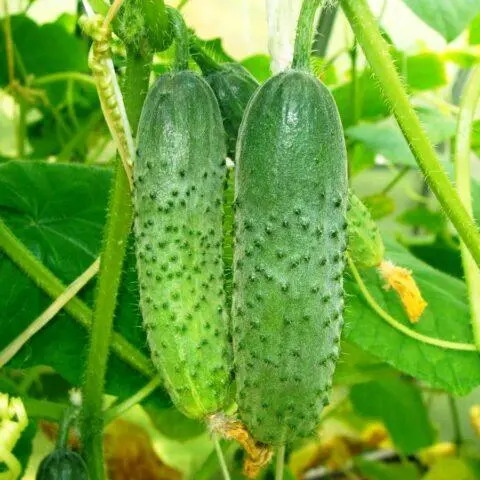
Mumu cucumbers have a good presentation
History of breeding
The originators of the culture are the Moscow Research Institute of Vegetable Breeding and the Gavrish Breeding Company. In 2010 Mumu cucumber F1 was entered into the State Register and approved for cultivation in the Northern, Northwestern, Central, Volga-Vyatka, Central Black Earth, North Caucasus and Middle Volga regions of the Federation.
Description of cucumbers Mumu F1
Mumu cucumber bushes are tall, medium-branched. The stems are creeping, rough, equipped with antennae, with which the plant clings to the supports.
The central stem of Mumu cucumber can reach a length of 1-2 m. Lateral shoots are determinate, that is, short. After reaching a certain length, they stop growing, which eliminates the need to pinch them.
The medium-sized light green leaves have a heart-shaped shape characteristic of representatives of this species. The surface of the leaf plate is covered with short hard villi.
The female-type flowers are yellow, five-petalled. Inflorescences are formed in bunches of 5-6 pieces each. Later, an ovary appears in place of the flower basket.
The fruits are oval-elongated, tuberous, dark green in color with barely noticeable white stripes and small black spikes. The skin is thin, strong. The length of one cucumber is 9-12 cm, diameter – 3-4 cm, weight about 110 g. The fruits are not prone to overgrowing and yellowing.
The pulp of cucumbers is juicy, crispy, with a small amount of seeds. The taste is pleasant, sweetish, without notes of bitterness inherent in some other varieties.
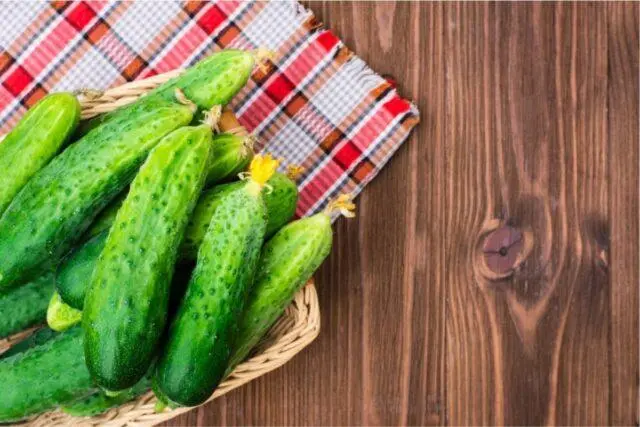
These cucumbers practically do not have empty flowers.
Characteristic of the variety
Every day, Mumu cucumbers are becoming more and more popular among gardeners. They owe this to their positive characteristics.
Productivity
Mumu hybrid is characterized as high-yielding. Subject to all the rules of agricultural technology from 1 square. m receive about 7 kg of ripe cucumbers.
The crop can be harvested at the stage of technical maturity (gherkins) and full, when the fruits reach the size characteristic of this type of vegetable.
Ripening and flowering time
Mumu F1 cucumbers are a mid-season hybrid, the flowering period of which begins approximately 30 days after the seeds enter the soil. The first fruits can be plucked after 40-50 days.
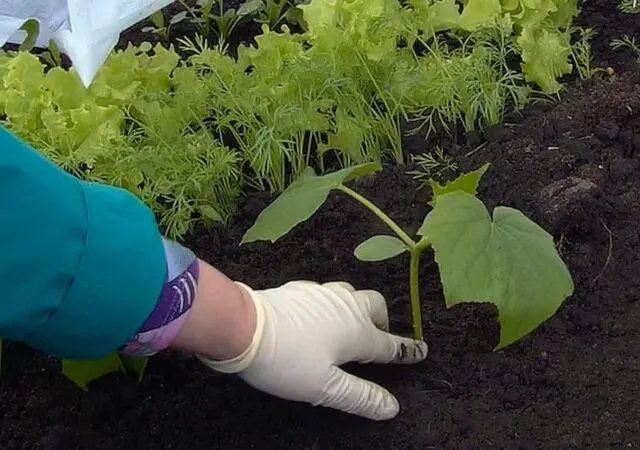
The fruiting period of cucumbers continues until autumn.
Disease and pest resistance
Mumu cucumbers have good resistance to diseases common to this crop, such as powdery mildew and olive blotch. They also get sick with root rot and downy mildew less often than other varieties and hybrids.
Advantages and disadvantages
Characterizing Mumu F1 cucumbers, gardeners list a number of advantages of this hybrid. However, it also has a couple of drawbacks.
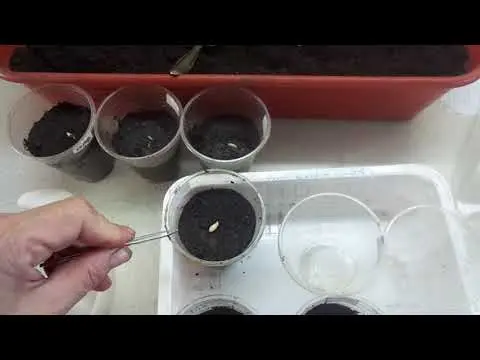
In the list of pluses, the ideal shape of cucumbers
Pros:
- attractive appearance of cucumbers and excellent taste;
- compactness and unpretentiousness;
- drought tolerance;
- high percentage of seed germination;
- self-pollination;
- lack of a tendency for cucumbers to grow;
- good yield;
- resistance to diseases;
- good transportability;
- universality of application.
Cons:
- impossibility of self-collection of seeds;
- relatively high cost of planting material.
Planting Mumu Cucumbers
Mumu cucumber seeds can be sown in containers for seedlings or directly into open ground.
In the first case, the seeds are planted in April. In open ground – when the soil warms up to +13 ° C and the threat of return frosts has passed. In central Our Country, this is approximately the beginning of May.
Sowing in open ground
For growing Mumu cucumbers, it is recommended to choose a sunny area with fertile permeable soil. Organic matter is preliminarily introduced into the depleted soil.
Cucumbers do not like excess moisture, so places with shallow groundwater are not suitable for growing them.
It is not recommended to plant a vegetable after beets, pumpkins and zucchini. Potatoes, peppers, onions, lettuce or peas will be good predecessors for this crop.
In the process of planting cucumbers in open ground:
- the site previously dug up and enriched with organic matter is leveled and shallow holes are made (about 8-9 pieces per 1 sq. m);
- water the wells and lay out the seeds of cucumbers in them (2-3 pieces each);
- cover the planting holes with soil and lightly tamp.
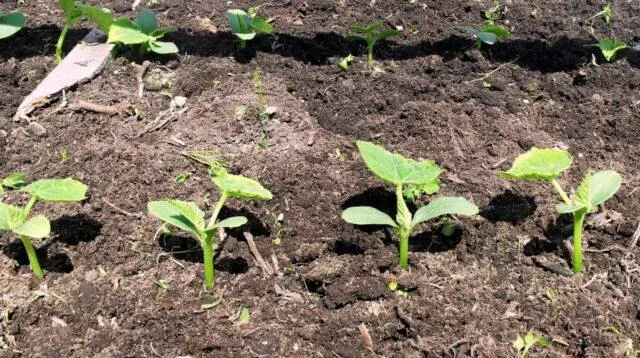
The distance between landings should be at least 25 cm
Seedbed method
In unprotected soil, seedlings are planted about three weeks after the seeds hit the ground. This must be taken into account when determining the date for sowing Mumu cucumbers for seedlings.
Damage to the root system during the transplantation of cucumber seedlings can cause the death of the plant. That is why seeds for seedlings are recommended to be applied not in one large container, but in individual containers.
The soil for cucumbers is desirable to use fertile permeable. You can buy it at the store or cook it yourself by combining humus, garden turf, sand and peat in equal proportions.
During boarding:
- fill the container with prepared soil;
- deepen the seeds of cucumbers into the soil by about 1 cm;
- moisten the earth in a container with a spray gun;
- close the cups with glass or plastic wrap and leave in a dry, warm place;
- after germination, the film is removed and the seedlings are placed on a well-lit windowsill.
For normal growth and development, it is necessary to provide cucumber seedlings with the right microclimate. The temperature in the room should be + 22-23 ° C, daylight hours – at least 13 hours. In case of a lack of natural light at night, cucumbers will have to be illuminated with special phytolamps or conventional fluorescent lamps.
Water the cucumbers as the soil dries in the container. Seedlings are planted in open ground after the formation of four true leaves.
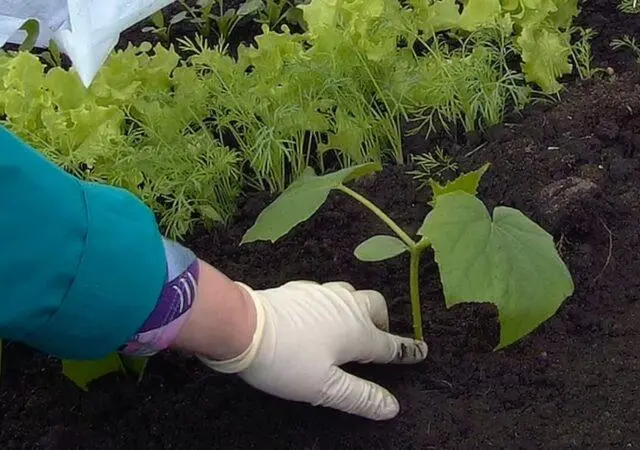
It is better to plant cucumbers in warm cloudy weather.
Rules for caring for Mumu cucumbers
For normal growth and fruiting of Mumu cucumbers, you need to provide them with proper care, which includes the following activities:
- Watering. The ideal option in this case would be drip irrigation, which will provide moisture directly to the roots of plants. If this is not possible, you need to water the cucumbers as the topsoil dries. The effect of cold on the root system may not be the best way to affect the condition of the whole plant, so it is advisable to use warm settled water.
- Seedling thinning. A large density of plantings can lead to stretching. Therefore, after germination, the extra seedlings of cucumbers are removed, leaving 1-2 pieces in the hole.
- Loosening the soil and removing weeds. It is recommended to loosen the soil after each watering of cucumbers. This will help improve the permeability of the soil and provide oxygen to the roots of the plants. Weeds are removed as they appear.
- Top dressing. Mumu cucumbers are fertilized every two weeks. Organics and ready-made mineral complexes are alternately used as compositions.
- Garter. To prevent thickening and improve air circulation, cucumbers are tied to a trellis, fixing one end of the rope under about 6-7 sheets, and the other on the crossbar.
- Prevention and treatment of diseases. Bad weather and improper care sometimes cause damage to cucumbers. In order to prevent the plants from flowering, they are sprayed with fungicidal preparations.
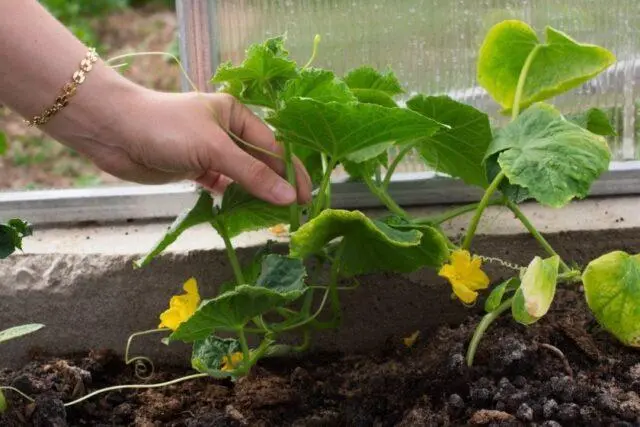
With the right agricultural technology, the plants will be strong and healthy.
Conclusion
Mumu cucumber is good for making salads and pickles. And the ability to grow it in a greenhouse allows you to have fresh vegetables on the table all year round.









